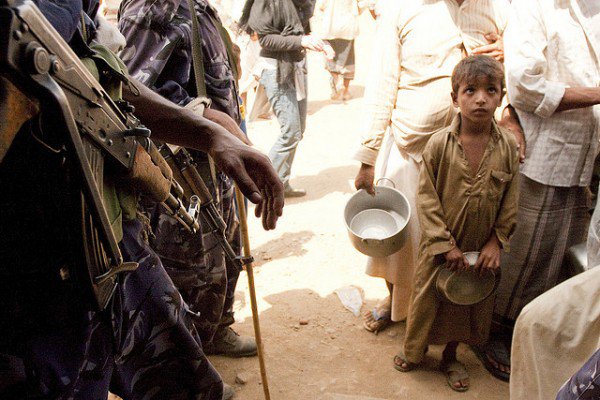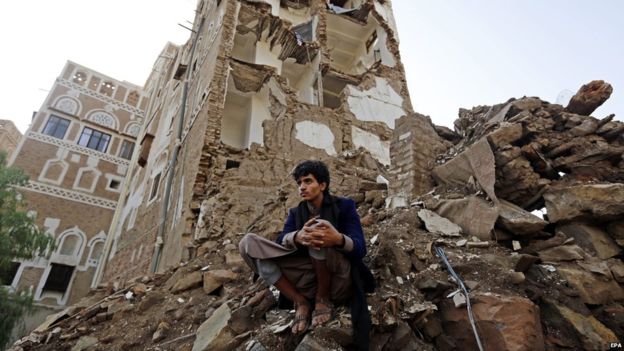‘Yemen after Five Months Looks Like Syria after Five Years’
MIDDLE EAST AND NORTH AFRICA, 14 Sep 2015
Michael Avender, CODEPink – TRANSCEND Media Service
The Humanitarian Crisis in Yemen: How the Saudi-Led Coalition and the US Government Guarantee No Visible End to the War
2 Sep 2015 – As Yemen rapidly disintegrates, the U.S. is turning a blind eye to atrocities committed by its Saudi allies — even as Washington enables them.
The crisis in Yemen has become catastrophic. Since the beginning of the Saudi-led coalition’s airstrikes on March 26, violence in Yemen has escalated significantly, leaving the nation decimated with little to no hope for an end in sight.
The Saudi-led coalition, backed by the United States, has been bombing Yemen for five months in order to quell the Houthis, a Shia rebel group that staged a coup to exile President Abd Rabbuh Mansour Hadi and take over the capital city of Sanaa. Violence between forces loyal to the exiled President Hadi, including indiscriminate airstrikes staged by the Saudi-led coalition, and Houthi rebel allies has left nearly 4,500 people dead and 23,000 injured in the past five months.
Hadi supporters and Houthi forces are not the only groups perpetrating violence in Yemen. The U.S. government continues to provide intelligence, weapons, and midair refueling to coalition aircrafts. Furthermore, U.S. warships have participated in the blockade in the Gulf of Aden and the southern Arabian Sea in order to impede the Houthi forces from receiving weapons shipments from Iran. Both Iranians and Houthis deny that such an exchange is occurring.
When asked about U.S. involvement in the massacre of Yemeni civilians, Commander Kevin Stephens, a U.S. military spokesman in Bahrain, stated, “The final decisions on the conduct of operations in the campaign are made by the members of the Saudi-led coalition, not the United States.” This is a clear attempt to take away any responsibility and accountability the U.S. has for the thousands of Yemenis who have been killed since coalition airstrikes began five months ago.
Peter Maurer, head of Red Cross International, told the AP that “Yemen after five months looks like Syria after five years” after returning from war-torn Yemen in August 2015. The increase in violence since March 2015 has exacerbated the existing issues that have plagued Yemen for years: poor governance, lack of rule of law, widespread poverty, and insufficient access to basic healthcare and water, among others.
The Saudi airstrikes against rebels have effectively destroyed Yemen’s infrastructure and have resulted in rigid restrictions on imports.
According to Oxfam, Yemen relies on imports to meet more than 80 percent of its national food consumption. Even before the escalation occurred, approximately half of the population — 10 million Yemenis — was already going hungry. The situation has grown more grave, as 20 million people are now in need of water and sanitation assistance, and 15 million lack access to basic health care. The Saudi-led coalition’s carnage of Yemen has impeded humanitarian access that would help ameliorate the crisis. The strict restrictions on food and fuel imports — compounded by the lack of funding humanitarian organizations have for sending relief to Yemen — leaves Yemen virtually helpless.
Meanwhile, Amnesty continues to report on Saudi-led coalition’s unlawful airstrikes, which often target heavily populated civilian areas with no military targets nearby. Amnesty has documented multiple case studies of hundreds of innocent civilians being killed by coalition airstrikes, often times the majority of the victims being women and children.
It seems, however, that it is not just the Saudi-led coalition displaying a blatant disregard for civilian lives. On the ground, both Houthi and anti-Houthi armed groups have killed and harmed civilians in their quest for the cities of Aden and Ta’iz — the majority of the attacks being aimed at residential neighborhoods. Whether in airstrikes or on-ground fighting, the result appears to be the same: the loss of civilian lives.
The most recent Saudi-led airstrike occurred on Sunday, August 30, at a water bottling factory, leaving 36 dead and dozens injured. Saudi Brigadier General Ahmed Asseri, a spokesperson for the Saudi-led coalition, claims that the factory was being used by Houthi forces to make explosives and train African migrants forced to take up arms. However, residents and medical officials state that the 36 people killed in the bombing were civilians.
Although confusion still remains surrounding the recent bombing, one thing remains clear: The bombings are continuing rampantly as the crisis in Yemen rapidly deteriorates.
__________________________
Michael Avender works at CODEPINK and is at Northeastern University on Human Services and Women’s Gender and Sexuality Studies.
DISCLAIMER: The statements, views and opinions expressed in pieces republished here are solely those of the authors and do not necessarily represent those of TMS. In accordance with title 17 U.S.C. section 107, this material is distributed without profit to those who have expressed a prior interest in receiving the included information for research and educational purposes. TMS has no affiliation whatsoever with the originator of this article nor is TMS endorsed or sponsored by the originator. “GO TO ORIGINAL” links are provided as a convenience to our readers and allow for verification of authenticity. However, as originating pages are often updated by their originating host sites, the versions posted may not match the versions our readers view when clicking the “GO TO ORIGINAL” links. This site contains copyrighted material the use of which has not always been specifically authorized by the copyright owner. We are making such material available in our efforts to advance understanding of environmental, political, human rights, economic, democracy, scientific, and social justice issues, etc. We believe this constitutes a ‘fair use’ of any such copyrighted material as provided for in section 107 of the US Copyright Law. In accordance with Title 17 U.S.C. Section 107, the material on this site is distributed without profit to those who have expressed a prior interest in receiving the included information for research and educational purposes. For more information go to: http://www.law.cornell.edu/uscode/17/107.shtml. If you wish to use copyrighted material from this site for purposes of your own that go beyond ‘fair use’, you must obtain permission from the copyright owner.
Read more
Click here to go to the current weekly digest or pick another article:
MIDDLE EAST AND NORTH AFRICA:

